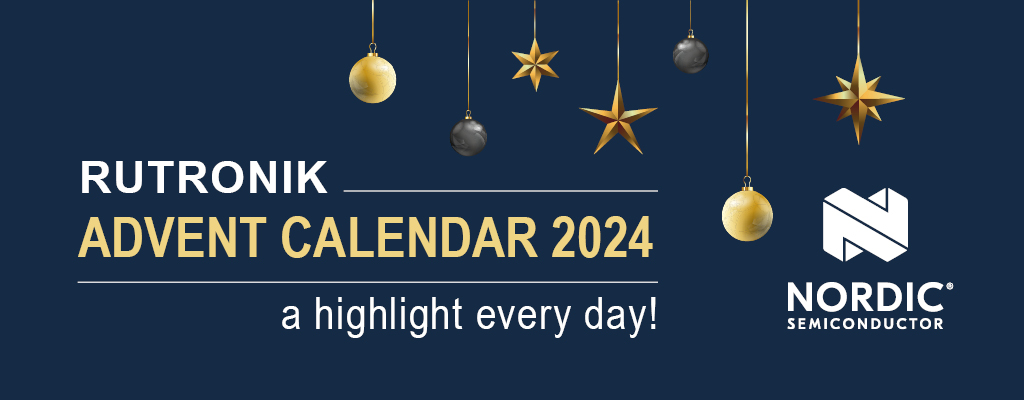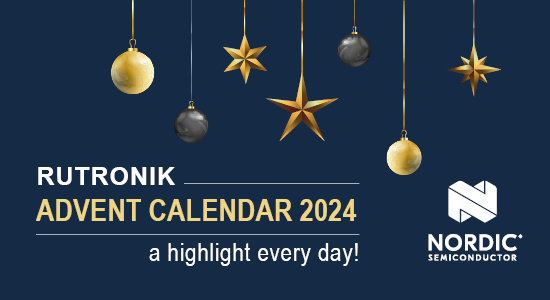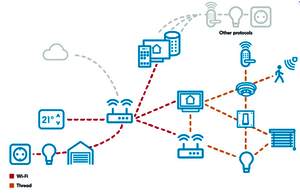Matter

Matter aims to make it easy for developers to create a secure and reliable solution. If you want your products to be interoperable with the major smart home ecosystems, Matter is the way to go. Matter, which began as Project CHIP (Connected Home over IP), was launched in December 2019. The starting companies were Amazon, Apple, Google, and others including Nordic Semiconductor. The goal is to agree on a unified application layer standard for connected things at home. Matter uses Thread, Wi-Fi + Ethernet for transport and Bluetooth® LE for commissioning. All Matter devices based on Thread must also support Bluetooth® LE to enable new devices to be added to a network. Wi-Fi can be used for both low and high bandwidth applications. It can be used for devices within range of the local Wi-Fi. Thread is an IPv6-based mesh protocol designed for low-bandwidth applications. It is the first choice for battery-powered devices that require the best energy efficiency and for simple actuators such as smart plugs or light bulbs. Most mains-connected Thread devices act as Thread routers, extending the reach of the network. Thread is a self-healing low-power mesh that can adapt to new devices or to devices as they are added or removed from the network.
The smart home market is relatively new and has a huge potential. It has been growing slower than expected in recent years. There is a plethora of proprietary solutions using different protocols and application layers. This has led to frustration among developers and consumers.
Matter steps in and provides a common foundation on which to build an application. The goal is to have interoperability between devices and ecosystems. As the former project name suggests, it is based on the Internet Protocol (IP). The IP is the most common network layer used in homes and offices. This makes it ideal for providing interoperability and security to devices and services.

Matter provides a standard application layer that is used with a number of wireless technologies. The focus is on Bluetooth LE, Thread, Wi-Fi, and Ethernet. Other IP-supporting protocols such as cellular will follow.
New version 1.4 unifies radio networks and helps with energy transition
Version 1.4 adds new capabilities to the standard to improve the interaction between different hardware control centers, wireless networks, and apps. In addition, new device types and functions expand energy management:
- Solar systems that include device types such as inverters, photovoltaic panels, and hybrid solar/battery systems.
- Batteries, such as those found in energy storage, battery walls, or storage systems (BESS), to buffer energy and discharge it when needed.
- Heat pumps for heating or cooling, whose operation can be shifted to off-peak hours.
- Water heaters with heating schedules that can be overridden if necessary to allow for rapid heating.
There also appear to be improvements in electric vehicle charging (EVSE) and heating control. Thermostat clusters now support schedules and presets for occupancy, absence, or vacation. There is also a new "Device Energy Management Mode" that optimizes the energy flow at three stages: device-specific, local to the building, or related to the public energy grid.
Getting started with Matter
To get started with your Matter product right, you can use the Nordic nRF52840 DK, nRF5340 DK, nRF7002 DK, or nRF54L15 DK. Using these kits, all the features of the SoCs can be used and tested. All analog and digital interfaces and GPIOs are available via pin headers and edge connectors. An onboard SEGGER J-Link allows programming, debugging, and even RTOS awareness during debugging. Both kits are Arduino Uno Rev3 hardware compatible, so they can be connected to device shields. The Nordic Power Profiler Kit II (PPK2) is a standalone kit for supplying and measuring currents from sub-µA up to 1A. The dedicated current measurement pins on our DKs can be used to connect DKs to a PPK2. The PPK2 can even use digital inputs and work as a low-end logic analyzer, allowing code-synchronous measurements.










